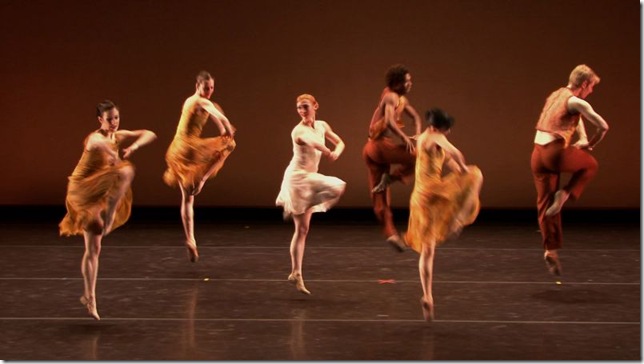If it’s true, as Sartre said, that Hell is other people, it isn’t a message that will find much support at Ballet Memphis.
The dance company, now celebrating its 25th year, brought four dances to the Duncan Theatre on Friday night in the first of two performances (the show is repeated tonight). Twelve members of the 23-person troupe from the blues capital were on stage for a modest, intimate show that generally celebrated togetherness in a variety of pleasing, effective movements.
This is a traditionally oriented ballet company, despite the modernity of some of the moves presented Friday night; what you got was good dance, quite decently done. Standout work came from Crystal Brothers as the focus of two pieces, Curtain of Green, a Eudora Welty-inspired piece choreographed by Julia Adam to etudes by Philip Glass, and S’Épanouir, a dance Jane Comfort and the company set to the music of saxophonist Kirk Whalum, himself a Memphis native.
Brothers, a petite redhead, has a strong stage presence that she reinforced in Curtain of Green with quick, precise motions of her hands, feet and torso, a crispness that was in deliberate sharp contrast to the accompanying dancers. The story of a widow who cannot come to terms with her husband’s sudden death, the ballet recounts the events by opening with Brothers in a solitary chair, facing upstage left, back to the audience, as her husband, danced by Steven McMahon, falls to the ground repeatedly.
Adam has underlined the repetitive returns in Glass’ minimalist etudes by having them coincide with Brothers placing a hand on McMahon’s leg, or jumping quickly into his arms, moves she performed expertly. This kind of visual punctuation worked well to underline the hopelessness of the woman’s situation, which Brothers further emphasized with rigid hand movements, somewhat like a broken machine that tries to keep working, and two new placements of her chair, always looking somewhere else but apparently seeing nothing.
Kendall G. Britt Jr. joined the dance in the second half, silently drawing a circle on the ground before the second Glass etude began, and like McMahon, added a few gentle, supportive moves, but it was Brothers’ dance to dominate. Adam brought a nice touch to things by ending with Brothers drawing the same circle Britt first introduced at the opening of the dance’s second half.
If the large Duncan audience was cool to Curtain of Green’s somber colors and soundtrack, they were much happier with S’Épanouir, which musically travels from Eric Dolphy-like solo ruminations to a mildly funky jazz ditty that at last gives way to some gospel piano noodling. Comfort’s scenario for Whalum’s piece of the same name is about bringing a woman in crisis back into the community, and this was a dance that was suffused with warmth and good intentions.
Brothers was again wonderful to watch, believable in her sorrow, graceful and elegant in her traversals of the stage, and when lifted at the end from the floor by the company to finish the dance with a ride on a pair of shoulders, she was the embodiment of relief at the end of travail. The other seven dancers did fine work in bringing Brothers back into the human fold, dancing with her one on one, then pairing off in couples to further advance the message of solidarity. With Brothers in white and the other dancers in browns and burgundies, the piece had a sort of summer-of-love vibe about it, and its energy grew slowly along with the music. This was an energetic, often athletic dance with lots of ideas, which perhaps reflects the communal input into its choreography; it gradually warmed from the opening to the ending, getting busier and busier, and the ending was beautifully timed to the music and ideally expressive of it.
The evening opened with Being Here With Other People, a dance choreographed by McMahon, a young Scotsman, to the finale of the Beethoven Violin Concerto. Eight dancers in cranberry pink smiled relentlessly through the dance, whether in couples or in the full ensemble. Various dancers came out to wave at the other dancers or the audience, and there was a kind of cutesy head tic that was repeated throughout as a signature mannerism.
This was a nice dance to watch, but it didn’t have much cohesion, either as a scenario or in the ensemble dancing, which was rather loose. It’s a charming idea, but it didn’t ingratiate, perhaps because it needed some sharper set pieces inside it to make it memorable and winning.
The program closed with In Dreams, Trey McIntyre’s reading of six songs recorded by Roy Orbison, the pop bard of the lovelorn during the last years before Beatlemania. This is a dance with real invention, and the company looked sharp and snappy throughout. The five dancers, garbed in black urban-cowboy-with-appliqué, slithered and strutted for the opening song, Dream Baby, and there were good solo moments for each of the women: Julie Niekrasz, Stephanie Hom and Virginia Pilgrim.
The difference in McIntyre’s style of choreography, at least as represented here, is that he designs his dances from core units, generally couples, rather than thinking of a scenario and adding dancers to it. The result is a dance that looks like a muscle, with a group of dancers packed tightly and acting off each other rather than off the whole group.
It’s intimate, sexy and powerful all at once, and that McIntyre, and Ballet Memphis, could sustain the audience’s interest even while two dancers moved in opposite directions off the stage over a recording of Orbison speaking rather than singing, is testimony to the power of dance to say something fresh even when the musical background is stagey, or not even that.
Ballet Memphis repeats this show tonight at 8 at the Duncan Theatre on the campus of Palm Beach State College in Lake Worth. Tickets are $37. Call 868-3309 or visit www.duncantheatre.org.
